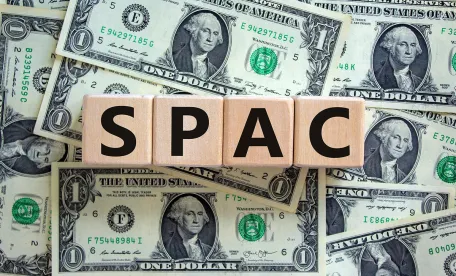The SEC has proposed wide-ranging new rules about special purpose acquisition companies (SPACs). The main thrust of the SEC’s proposal is to put a business combination between a SPAC and a private operating company – the so-called “de-SPAC” transaction whereby the operating company is ushered into the public market – on roughly the same disclosure and liability footing as a traditional IPO.1
The proposal is subject to a public comment period ending 30 days after its publication in the Federal Register or May 31, 2022, whichever is later.
Of the many constituencies potentially affected by the SEC’s proposal, there is one that has received relatively little attention to date. These are the institutional investors, primarily including hedge funds, that provide PIPE financing in support of de-SPAC transactions.2 The proposal raises the novel and disturbing suggestion that an investor who subscribes to a de-SPAC PIPE offering might for that reason be deemed a Securities Act “underwriter” of the de-SPAC transaction. A PIPE investor with de-SPAC underwriter status would be exposed to potential liability for inaccuracies in the Securities Act registration statement filed by the SPAC in connection with the transaction.3 Facing liability of this sort would be a game-changer for hedge funds that have made de-SPAC PIPEs part of their investment strategy.
The suggestion that de-SPAC PIPE investors might be underwriters arises in the larger context of proposed Rule 140a (itself a novel construct), which would deem certain SPAC IPO underwriters also to be underwriters of the subsequent de-SPAC transaction. It is therefore useful to understand the expansive SEC concept of underwriter status underlying that proposed new rule. We start with a brief refresher about the statutory definition of underwriter.
The Definition of “Underwriter”
Section 2(a)(11) of the Securities Act defines an “underwriter” as any person “who has purchased from an issuer with a view to, or offers or sells for an issuer in connection with, the distribution of any security, or participates or has a direct or indirect participation in any such undertaking….” Thus, to be an underwriter, a person must be involved in a “distribution” of securities. There is no statutory definition of a distribution, but it is widely acknowledged to mean a public offering of securities and is generally understood to continue until the offered securities have “come to rest” with the investing public.
The first two prongs of the Section 2(a)(11) underwriter definition – purchasing securities from the issuer in order to sell them on to the public, or acting for the issuer in offering or selling its securities to the public – are the activities normally thought of as “underwriting” within the day-to-day business meaning of the term. A traditional example is an IPO, in which an investment banking firm purchases shares from the issuer and then promptly resells them to the public at a specified higher price.
The third prong of Section 2(a)(11) – “participating” directly or indirectly in a distribution – is less intuitive. While there is limited case law and guidance interpreting the concept, the proposal notes that courts and the SEC have found that participation may mean engaging in activities “necessary to the distribution” or in “distribution-related activities.”4
A person with underwriter status is presumptively liable to purchasers of the offered securities for any material misstatements or omissions in the issuer’s Securities Act registration statement relating to the distribution. An underwriter can defeat liability by establishing the so-called “due diligence defense.” The defense essentially requires the underwriter to demonstrate that it exercised reasonable care to confirm the accuracy and completeness of the disclosure contained in the registration statement. That is a serious and time-consuming task.5
A New Idea: De-SPAC Transactions Can Have Underwriters
As noted, grasping the proposal’s potential impact on hedge funds who provide de-SPAC PIPE financing first requires an appreciation of proposed Rule 140a and the SEC thinking behind it. The proposed rule would deem an underwriter of a SPAC IPO in certain cases to be an “underwriter” of the subsequent de-SPAC transaction as well. This is an aggressive move by the SEC, since market participants historically have not perceived the statutory definition of underwriter to cover activities undertaken in connection with de-SPAC transactions.
The proposal’s first step in asserting that de-SPAC transactions may have underwriters is to make clear that, in the SEC’s view, a de-SPAC transaction involves a “distribution” on the part of the combined company. Specifically, the proposal maintains that a de-SPAC transaction is the second leg of a unitary distribution that begins with the SPAC IPO and ends with the de-SPAC closing. In the proposal’s telling, such a unified distribution takes place because, in its IPO, the SPAC receives assets in the form of cash; and then, in the de-SPAC transaction, “the combined company effectively distributes its securities to public holders of SPAC shares in exchange for the contribution of the SPAC’s assets to the combined company.” The proposal concludes that the result of a de-SPAC transaction is “consistent with” the more rapid one-step distribution that occurs in a traditional IPO.
The proposal introduces proposed Rule 140a on the back of the above analysis. The new rule would deem a SPAC IPO underwriter also to be a de-SPAC underwriter if it “takes steps to facilitate the de-SPAC transaction, or any related financing transaction, or otherwise participates (directly or indirectly) in the de-SPAC transaction.”6
The proposal suggests several activities by which a SPAC IPO underwriter might demonstrate sufficient “participation” to become a de-SPAC underwriter in the eyes of Rule 140a. These include acting as a financial adviser to the SPAC, identifying potential target operating companies, negotiating the eventual business combination agreement, or arranging a de-SPAC PIPE offering.
A de-SPAC underwriter under Rule 140a would face the above-described Securities Act liability for material misstatements or omissions in the de-SPAC registration statement on Form S-4 or F-4. Under a separate proposed rule, the persons to whom a de-SPAC underwriter could be liable would include not only target company shareholders, but also former public SPAC shareholders who elect to continue as investors in the combined company.7
A Possible Further Step: Hedge Fund PIPE Investors as De-SPAC Underwriters?
Of course, hedge funds do not underwrite SPAC IPOs. Nonetheless, hedge funds that provide de-SPAC PIPE financing should be deeply concerned by the aggressive SEC attitude toward participation-based underwriter status that underlies proposed Rule 140a. That attitude is on full display in the proposal’s discussion that follows its description of the proposed rule.
The proposal cautions that Rule 140a and the accompanying list of activities potentially indicating de-SPAC underwriter status pursuant thereto are “not intended to provide an exhaustive assessment of underwriter status in the SPAC context.” In particular, the proposal states that federal courts or the SEC “may find” that a party other than a SPAC IPO underwriter has de-SPAC underwriter status due to “perform[ing] activities necessary to the successful completion” of a de-SPAC transaction. In this connection, the proposal says that a de-SPAC PIPE investor, depending on circumstances, could be deemed an underwriter due to “‘participating’ in a distribution” relating to the de-SPAC transaction.
This is hair-raising stuff for hedge funds that invest in de-SPAC PIPEs. It is often the case that the provision of PIPE financing is practically “necessary to the successful completion” of a de-SPAC transaction. This fact, coupled with the proposal’s assertion that a de-SPAC transaction entails a distribution, suggests that the SEC has an eye toward – or at least is open to – pushing the “underwriter” envelope to ensnare hedge funds whose only connection to a de-SPAC transaction is investing the PIPE capital needed for its consummation.
Underwriter status for de-SPAC PIPE investors would alter their legal risk exposure radically by exposing them to potential Securities Act liability for misstatements or omissions in the Form S-4 or F-4 registration statement addressed to the target company owners and continuing SPAC shareholders (including any disclosed projections). If PIPE investors were in fact at risk of underwriter status, they somehow would need to engage in a strenuous investigation of the registration statement’s contents, which it is unclear how they would be positioned to accomplish.8
The prospect of de-SPAC underwriter liability is already deeply troubling to the SPAC IPO underwriters who would be subject to proposed Rule 140a. Extending it to hedge funds who do nothing more than supply critical de-SPAC PIPE financing would be an even more unexpected, boundary-pushing step.
What Comes Next?
The proposal as a whole has engendered vigorous market reaction, which doubtless will continue through the end of the public comment period. In a sense, though, the extent to which any particular elements of the proposal are adopted may be largely irrelevant to de-SPAC PIPE providers – there appears no reason not to assume that the far-reaching view of underwriter status expressed in the proposal has independent conceptual vitality in the SEC’s view. If the proposal truly reflects the possibility that de-SPAC PIPE investors may be underwriters within the meaning of Section 2(a)(11), many hedge funds that have made a practice of subscribing to de-SPAC PIPES would be expected to rethink the advisability of that strategy. Any retreat on their part would affect the broader SPAC ecosystem significantly.
-
In a classic de-SPAC transaction, a SPAC, which until that point has been a publicly traded shell company with assets consisting largely of its cash IPO proceeds, engages in a business combination with a private operating company. In connection with the de-SPAC transaction, the SPAC issues SEC-registered shares to the operating company owners and contributes its available cash to the operating company. Those SPAC public shareholders that have not elected to redeem their SPAC shares in connection with the de-SPAC transaction continue as shareholders of the newly combined company. When the de-SPAC dust has settled, the target company effectively has become a publicly traded issuer with a shareholders base that includes the former private company’s owners and some of the SPAC’s prior public shareholders.
-
Most de-SPAC transactions include a PIPE, and hedge funds are the chief subscribers. The PIPE is a common feature of a de-SPAC transaction because a SPAC normally grants its public shareholders the opportunity to redeem their SPAC shares rather than carrying on as shareholders of the combined company. To guard against the possibility of redemptions overly depleting the amount of cash the SPAC can deliver to the target company (a minimum quantity of which is often required under the business combination agreement), a SPAC typically lines up a PIPE financing scheduled to close concurrently with the de-SPAC transaction.
-
As noted, a SPAC typically issues securities to the target operating company’s owners as part of the de-SPAC transaction. In order for those securities to be freely tradable, the SPAC registers their issuance on Form S-4 or F-4, a specialized type of Securities Act registration statement used for the issuance of securities as consideration in an M&A transaction. While it is the SPAC that registers and issues the securities, the securities once issued are effectively securities of the newly public combined company. The Form S-4 or F-4 contains voluminous information (which the proposal would make more voluminous) about the terms of the de-SPAC transaction and the business and financial position of the combined company.
-
See Release No. 33-11048 at notes 186-191 and accompanying text. The proposal also points to a 1938 statement by the SEC’s general counsel indicating that underwriter status under the “participation” prong of Section 2(a)(11) depends on the putative underwriter “enjoying substantial relationships with the issuer or underwriter, or engaging in the performance of any substantial functions in the organization or management of the distribution.” Id. at note 194 and accompanying text.
-
Presumptive underwriter liability arises primarily under Section 11(a) of the Securities Act. The due diligence defense is provided in Section 11(b), which states that an underwriter will not be liable for defective disclosure in the issuer’s registration statement if the underwriter can demonstrate that, “after reasonable investigation,” it had reasonable grounds to believe (and did believe) the disclosure in question was accurate and complete when the registration statement became effective. Traditional underwriters and their counsel therefore devote significant effort to substantiating the contents of the registration statement.
-
Proposed Rule 140a is limited to “registered” de-SPAC transactions, meaning de-SPAC transactions that feature the filing of a Securities Act registration statement. That covers basically all de-SPAC transactions.
-
Proposed Rule 145a would treat a de-SPAC transaction as involving a deemed “sale” of the combined company’s securities to those public SPAC shareholders who elect to continue as shareholders of the combined company. This deemed sale would be need to be registered on the same Form S-4 or F-4 that the SPAC uses to register its issuance of shares to the target company’s owners.
-
The SEC itself seems aware of this practical challenge. With respect to proposed Rule 140a, the proposal seeks public comment on whether a SPAC IPO underwriter would “have the means and access necessary (via contract or otherwise) to perform due diligence at the de-SPAC transaction stage ….” That question applies a fortiori in the case of de-SPAC PIPE investors.





 />i
/>i

